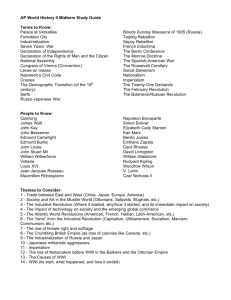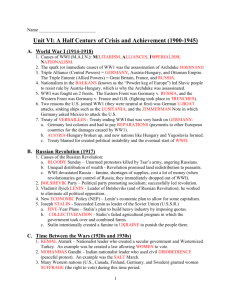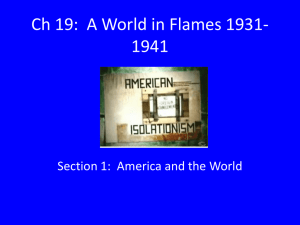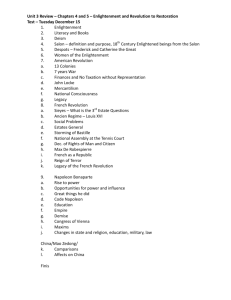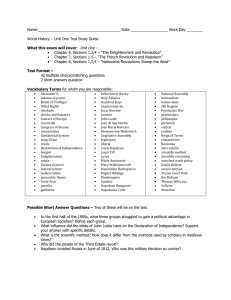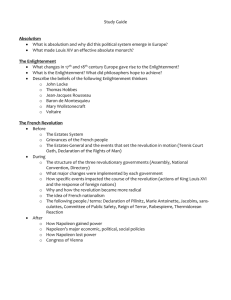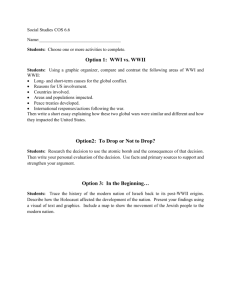World Civ B Final Exam Study Guide
advertisement
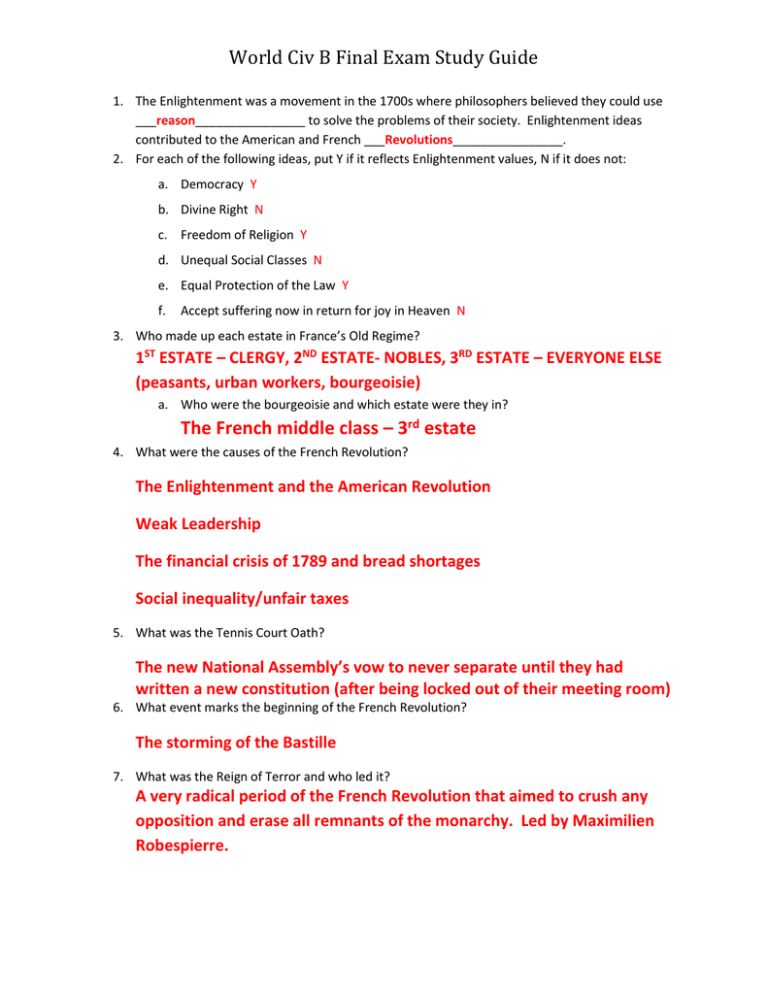
World Civ B Final Exam Study Guide 1. The Enlightenment was a movement in the 1700s where philosophers believed they could use ___reason________________ to solve the problems of their society. Enlightenment ideas contributed to the American and French ___Revolutions________________. 2. For each of the following ideas, put Y if it reflects Enlightenment values, N if it does not: a. Democracy Y b. Divine Right N c. Freedom of Religion Y d. Unequal Social Classes N e. Equal Protection of the Law Y f. Accept suffering now in return for joy in Heaven N 3. Who made up each estate in France’s Old Regime? 1ST ESTATE – CLERGY, 2ND ESTATE- NOBLES, 3RD ESTATE – EVERYONE ELSE (peasants, urban workers, bourgeoisie) a. Who were the bourgeoisie and which estate were they in? The French middle class – 3rd estate 4. What were the causes of the French Revolution? The Enlightenment and the American Revolution Weak Leadership The financial crisis of 1789 and bread shortages Social inequality/unfair taxes 5. What was the Tennis Court Oath? The new National Assembly’s vow to never separate until they had written a new constitution (after being locked out of their meeting room) 6. What event marks the beginning of the French Revolution? The storming of the Bastille 7. What was the Reign of Terror and who led it? A very radical period of the French Revolution that aimed to crush any opposition and erase all remnants of the monarchy. Led by Maximilien Robespierre. World Civ B Final Exam Study Guide 8. Who were the king and queen killed during the French Revolution? Louis XVI and Marie Antoinette 9. Who overthrew the Directory and ruled France from 1799 to 1815? Napoleon Bonaparte 10. Where was Napoleon born? Exiled to the first time? Exiled to second time and where he died? Corsica; Elba; St. Helena 11. Define the Continental System. Napoleon’s attempt to cripple Great Britain’s economy by cutting it off from trade with Continental Europe. 12. Identify the Battle of Trafalgar/Crossing the T Strategy: An important loss for Napoleon because it ruined his hopes of a French invasion of Great Britain. Two English fleets sailed in a T-formation to defeat the French navy. 13. The Russians used the ___scorched_______-____earth_______ policy to destroy all crops and shelters so the French troops could not use them to survive. 14. What was Napoleon’s final battle? Waterloo 15. The Congress of Vienna met to restore order to Europe because of the changes caused by? Napoleon 16. This movement is based on the belief that each group of people has its own cultural identify and should be united under their own self-governing state: _______nationalism_____________________ 17. The first mechanized industry (which started in GB) was the ____textile____________ industry. World Civ B Final Exam Study Guide 18. The key power source of the Industrial Revolution was the ___steam engine__________________, invented by James Watt. 19. One major effect of the Industrial Revolution was rapid urbanization. What is this? Mass movement of people from the countryside to cities. 20. This co-author of The Communist Manifesto hated capitalism because he believed it created wealth for a few and poverty for most. He thought that profits were really wages stolen from workers. He urged the proletariat or __working class____________________ to rise up together against the owners. Who was he? Karl Marx 21. Be able to differentiate between Capitalism/Socialism/Communism. Cap-Private ownership of businesses, free from government intervention Soc-Some private property, but the means of production are owned and operated by the government Comm-A more extreme of Socialism where there is no private ownership of property – the economy and government are run by a single dictator or authoritarian party a. Know laissez-faire/Adam Smith/Wealth of Nations “hands-off” – the father of capitalism – he wrote the Wealth of Nations advocating for a free market economy 22. What topic is illustrated by the following image? imperialism 23. What continent was almost completely colonized by the major European countries in the late 1800s/early 1900s? Africa 24. List the causes/justifications for the Age of New Imperialism: Social Darwinism, racism, economic benefits, political and military benefits, humanitarianism 25. Review the 1800s Isms Quiz: know terms including Social Darwinism, Anti-Semitism, Nationalism and all the events relating to them (the Dreyfus Affair, the Franco-Prussian War, etc…) World Civ B Final Exam Study Guide 26. List the 4 MAIN underlying causes of World War I. Militarism Alliances Imperialism Nationalism 27. What were the 2 opposing alliance systems in place prior to WWI? Name the countries included. Hint: IGA vs GB R F Triple Alliance: Italy, Germany, Austria Triple Entente: Great Britain, Russia, France 28. Whose assassination started WWI? Franz Ferdinand – the archduke of Austria 29. WWI took place between the years of __1914______ and ____1918_____. 30. What were the 2 sides in WWI called? Allies and Central Powers 31. What type of warfare primarily characterized WWI? Trench Warfare 32. Why was Germany blamed for WWI, even though it was not one of the 2 countries initially involved? “Blank Check” of support to Austria encouraging war, many aggressive actions including invading Belgium (a neutral country) at the beginning of the war 33. What year did the US join WWI and why? 1917 – mostly because of the Zimmermann Telegram and Germany resuming unrestricted submarine warfare. Also because of close cultural and economic ties to the Allies and Russia became democratic. 34. Name the treaty that settled WWI and why it was flawed. Treaty of Versailles – punished Germany too harshly and contributed to their economic hardships and resentment, ultimately leading to Hitler’s popularity and WWII. 35. What was the name of the book Hitler wrote while in prison? Mein Kampf 36. The laws that stripped Jews of citizenship rights were called the ____Nuremburg Laws____________________. 37. The strong line of fortifications that the French built along their border with Germany was called the… ____Maginot Line____________________. 38. __Japan________ started a pattern of aggressive expansionism in the 1930s by invading Manchuria and other key cities in China, as well as several islands in the Pacific. 39. Italy expanded by invading _____Ethiopia_____________ in 1935. World Civ B Final Exam Study Guide 40. Adolf Hitler’s building up of the German army and remilitarization of the Rhineland are examples of how he violated the…? ______Treaty of Versailles_________________________________ 41. At first, world leaders followed a policy of ____appeasement_________________ with Hitler, meaning they gave in to his demands in order to keep peace. 42. Name 2 regions and/or countries Hitler annexed before World War II started. The Rhineland, Austria, the Sudetenland, Czechoslovakia 43. The Nonaggression Pact that Hitler signed with Stalin before World War II started included a secret agreement for the two leaders to divide which country? Poland 44. Hitler’s invasion of ____Poland_______________ on September 1, 1939 is the event that forces GB and France to declare war, officially starting World War II. The war ended in __1945_______. 45. What was the only country in Western Europe Hitler was not able to conquer? United Kingdom 46. The US was officially neutral and stayed out of WWII until the Japanese bombed Pearl Harbor. However, what legislation allowed President Roosevelt to bypass the Neutrality Acts to help Great Britain against Germany? The Lend-Lease Act 47. When was Pearl Harbor bombed? Dec 7, 1941 48. The two sides in WWII were the Axis and Allies. Identify the 3 main countries that represented each side. Axis Powers – Japan, Italy, Germany (Leaders were Tojo, Mussolini, and Hitler) Allies: United States, UK, USSR (Leaders were FDR, Churchill and Stalin) 49. ____D-Day__________________ refers to the date when Allied troops finally invaded Europe at Normandy in France. (June 6, 1944). 50. Identify the following facts related to the atomic bomb(s) used in WWII: a. b. c. d. Code name for the research: The Manhattan Project Airplane that dropped first bomb: The Enola Gay Two cities where they were dropped: Hiroshima (Aug. 6) and Nagasaki (Aug 9) President who ordered it: Harry S Truman World Civ B Final Exam Study Guide
